Envisat Ocean Altimetry Performance Assessment and Cross-calibration
Abstract
:1. Introduction
2. Data used and processing
3. Data coverage and edited measurements
3.1 Missing measurements
3.2 Edited measurements
4. Long term monitoring of altimeter and radiometer parameters
4.1 Number and standard deviation of 20Hz elementary Ku-band measurements
4.2 Off-nadir angle from waveforms
4.3 Significant Wave Height
4.4 Backscatter coefficient
4.5 Dual-frequency ionosphere correction
4.6 MWR wet troposphere correction
5. Sea Surface Height performance assessment
5.1 High Frequency signals investigation
5.2 Crossover mean
5.3 Variance at crossovers
6. Mean Sea Level. Envisat SSH bias
7. Comparison to tide gauges
8. Conclusions
Acknowledgments
References
- Dorandeu, J.; Faugere, Y.; Mertz, F.; Mercier, F.; Tran, N. Calibration / Validation of Envisat GDRs Cross-calibration / ERS-2, Jason-1. Envisat & ERS Symposium, Salzburg, Austria; 2004. [Google Scholar]
- Faugere, Y.; Mertz, F.; Dorandeu, J. Envisat GDR quality assessement report (cyclic). Technical Note SALP-RP-P2-EX-21072-CLS015. 2003. Available at: http://www.aviso.oceanobs.com/html/donnees/calval/validation_report/en/welcome_uk.html.
- Dorandeu, J.; Ablain, M.; Faugere, Y.; Mertz, F.; Soussi, B. Jason-1 global statistical evaluation and performance assessment. Calibration and cross-calibration results. Mar. Geod. 2004, 27(3-4), 345–372. [Google Scholar]
- Stum, J.; Ogor, F.; Le Traon, P.Y.; Dorandeu, J.; Gaspar, P.; Dumont, J.P. An intercalibration study of TOPEX/POSEIDON, ERS-1 and ERS-2 altimetric missions. Final report of IFREMER contract N_97/2 426 086/C CLS.DOS/NT/98.070 1998. [Google Scholar]
- Doornbos, E.; Scharroo, R. Improved ERS and Envisat precise orbit determination. Proc. of the 2004 Envisat & ERS Symposium, Salzburg, Austria; 2005. [Google Scholar]
- Celani, C.; Greco, B.; Martini, A.; Roca, M. Instruments corrections applied on RA-2 Level-1B Product. Proceeding of the Envisat Calibration Workshop; 2002. [Google Scholar]
- Martini, A. Envisat RA-2 Range instrumental correction: USO clock period variation and associated auxiliary file. Technical Note ENVI-GSEG-EOPG-TN-03-0009. 2003. Available at http://earth.esa.int/pcs/envisat/ra2/articles/USO_clock_corr_aux_file.pdf.
- Product Control Service web site: USO Clock Period Measurements. Available at http://earth.esa.int/pcs/envisat/ra2/auxdata/.
- Dedieu, M.; Eymard, L.; Obligis, E.; Tran, N.; Ferreira, F. ENVISAT Microwave Radiometer Assessment Report Cycle 039. Technical Note CLS.DOS/NT/05.147. 2005. Available at http://earth.esa.int/pcs/envisat/mwr/reports.
- Laxon, S.; Roca, M. ENVISAT RA-2: S-Band Performance. Proceedings of the ENVISAT Calibration Workshop, Noordwijk; 2002. [Google Scholar]
- Martini, A.; Femenias, P.; Alberti, G.; Milagro-Perez, M. P. Ra-2 S-band anomaly detection and waveforms reconstruction. Proc. of the 2004 Envisat & ERS Symposium, Salzburg, Austria; 2005. [Google Scholar]
- Faugere, Y.; Mertz, F.; Dorandeu, J. Envisat validation and cross calibration activities during the verification phase. Synthesis report. Technical Note CLS.DOS/NT/03.733, ESTEC contract N°16243/02/NL/FF WP6. 2003. Available at: http://earth.esa.int/pcs/envisat/ra2/articles/Envisat_Verif_Phase_CLS.pdf.
- Lillibridge, J.; Scharroo, R.; Quartly, G. Rain and ice flagging of Envisat altimeter and MWR data. Proc. of the 2004 Envisat & ERS Symposium, Salzburg, Austria; 2005. [Google Scholar]
- Faugere, Y.; Mertz, F.; Dorandeu, J. Envisat RA-2/MWR ocean data validation and cross-calibration activities. Yearly report. Technical Note CLS.DOS/NT/04.289, Contract N° 03/CNES/1340/00-DSO310. 2004. Available at: http://earth.esa.int/pcs/envisat/ra2/articles/Envisat_Yearly_Report_2004.pdf.
- Rudolph, A.; Kuijper, D.; Ventimiglia, L.; Garcia Matatoros, M. A.; Bargellini, P. Envisat orbit control - philosophy experience and challenge. Proc. of the 2004 Envisat & ERS Symposium, Salzburg, Austria; 2005. [Google Scholar]
- Zanife, O. Z.; Vincent, P.; Amarouche, L.; Dumont, J. P.; Thibaut, P.; Labroue, S. Comparison of the Ku-band range noise level and the relative sea-state bias of the Jason-1, TOPEX and Poseidon-1 radar altimeters. Mar. Geod. 2003, 26(3-4), 201–238. [Google Scholar]
- Vincent, P.; Desai, S. D.; Dorandeu, J.; Ablain, M.; Soussi, B.; Callahan, P. S.; Haines, B. J. Jason-1 Geophysical Performance Evaluation. Mar. Geod. 2003, 26(3-4), 167–186. [Google Scholar]
- Roca, M.; Martini, A. Level 1b Verification updates. Ra2/MWR CCVT meeting ESRIN, Rome; 2003. [Google Scholar]
- Witter, D. L.; Chelton, D. B. A Geosat altimeter wind speed algorithm development. J. Geophys. Res. (Oceans) 1991, 96, 8853–8860. [Google Scholar]
- Le Traon, P.-Y.; Stum, J.; Dorandeu, J.; Gaspar, P.; Vincent, P. Global statistical analysis of TOPEX and POSEIDON data. J. Geophys. Res. 1994, 99, 24619–24631. [Google Scholar]
- Chambers, D. P.; Ries, J.; Urban, T.; Hayes, S. Results of global intercomparison between TOPEX and Jason measurements and models. Paper presented at the Jason-1 and TOPEX/Poseidon Science Working Team Meeting, Biarritz (France), 10–12 June 2002.
- Labroue, S. RA-2 ocean and MWR measurement long term monitoring, Final report for WP3, Task 2, SSB estimation for RA-2 altimeter. Technical Note CLS-DOS-NT-04-284 2004. [Google Scholar]
- Obligis, E.; Eymard, L.; Tran, N.; Labroue, S.; Femenias, P. First three years of the Microwave Radiometer Aboard ENVISAT : In-flight calibration, Processing and Validation of the geophysical products. J. Atmos. and Oceanic Technol. In press. 2006. [Google Scholar]
- Tran, N.; Obligis, E.; Eymard, L. Evaluation of Envisat MWR 36.5 GHz drift. Technical note CLS-DOS-NT-05-073 2005. [Google Scholar]
- Labroue, S.; Gaspar, P. Comparison of non parametric estimates of the TOPEX A, TOPEX B and JASON 1 sea state bias. Paper presented at the Jason 1 and TOPEX/Poseidon SWT meeting, New-Orleans, 21–12 October 2002.
- Labroue, S. Non parametric estimation of ENVISAT sea state bias. Technical note CLS.DOS/NT/03.741, ESTEC Contract n°16243/02/NL/FF - WP3 Task 2 2003. [Google Scholar]
- Tran, N.; Hancock, D. W., III; Hayne, G.S. Assessment of the cycle-per-cycle noise level of the GEOSAT Follow-On, TOPEX and POSEIDON. J. Atmos. and Oceanic Technol 2002, 19(12), 2095–2117. [Google Scholar]
- Scharroo, R. A decade of ERS Satellite Orbits and Altimetry. PhD Thesis, Delft University Press Scienc, 2002. [Google Scholar]
- EOP-GOQ and PCF team; Envisat Cyclic Altimetric Report. Technical Note ENVI-GSOP-EOPG-03-0011. 2005. available at http://earth.esa.int/pcs/envisat/ra2/reports/pcs_cyclic.
- Dorandeu, J.; Le Traon, P.Y. Effects of Global Atmospheric Pressure Variations on Mean Sea Level Changes from TOPEX/Poseidon. J. Atmos. and Oceanic Technol. 1999, 16, 1279–1283. [Google Scholar]
- Luthcke, S. B.; Zelinsky, N. P.; Rowlands, D. D.; Lemoine, F. G.; Williams, T. A. The 1-Centimeter Orbit: jason-1 Precision Orbit Determination Using GPS, SLR, DORIS, and Altimeter Data. Mar. Geod. 2003, 26(3-4), 399–421. [Google Scholar]
- Mitchum, G. Comparison of TOPEX sea surface heights and tide gauge sea levels. J. Geophys. Res. 1994, 99, 24541–24554. [Google Scholar]
- Mitchum, G. Monitoring the stability of satellite altimeters with tide gauges. J. Atmos. Oceanic. Technol. 1998, 15, 721–730. [Google Scholar]
- Cazenave, A.; Dominh, K.; Ponchaut, F.; Soudarin, L.; Cretaux, J. F.; Provost, C. L. Sea Level Change from Topex/Poseidon altimetry and tide gauges, and vertical crustal motions from DORIS. Geophys. Res. Let. 1999, 26, 2077–2080. [Google Scholar]
- Lefèvre, F.; Sénant, E. ENVISAT relative calibration. Technical Note CLS-DOS-NT-05.074 2005. [Google Scholar]
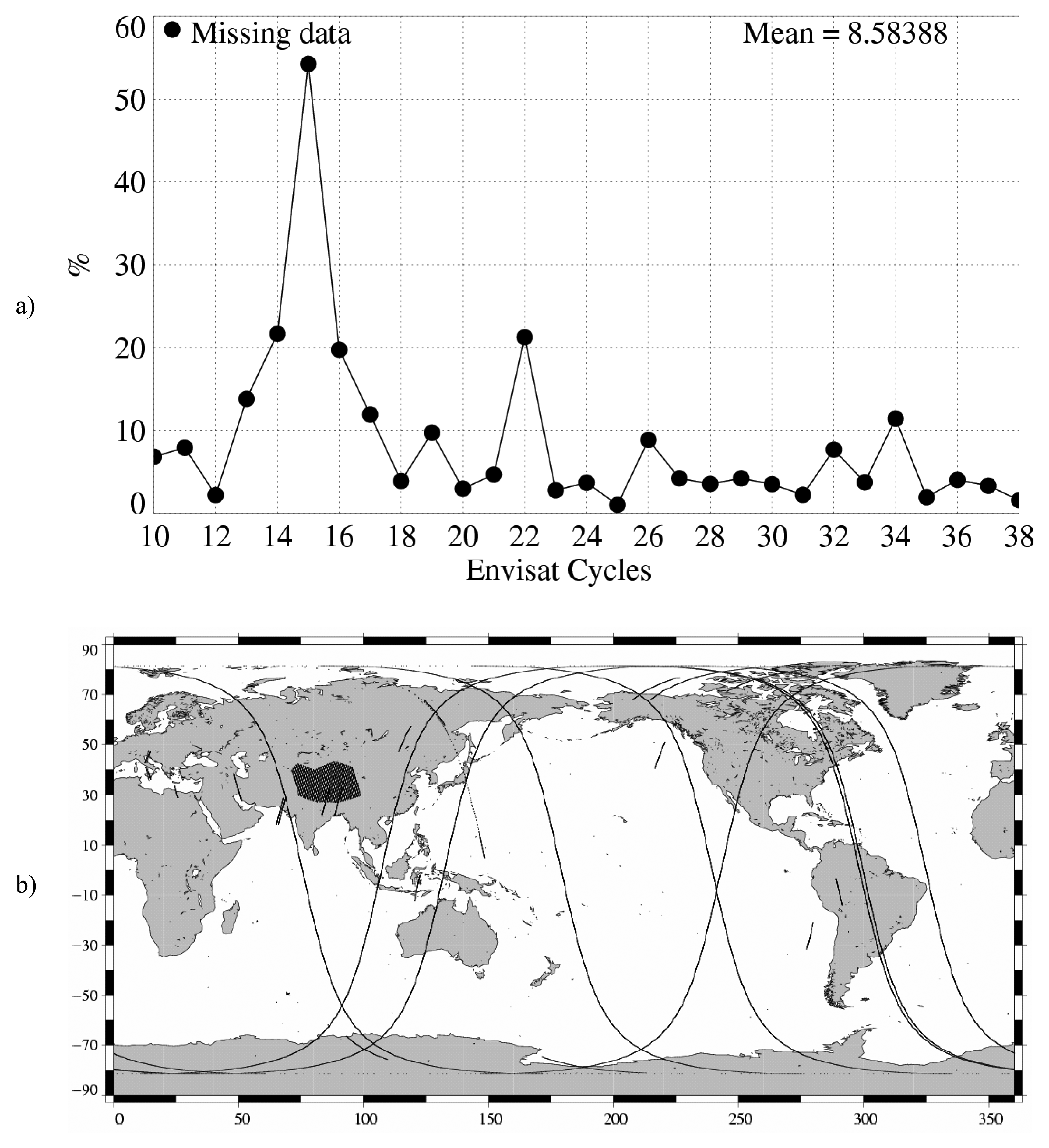
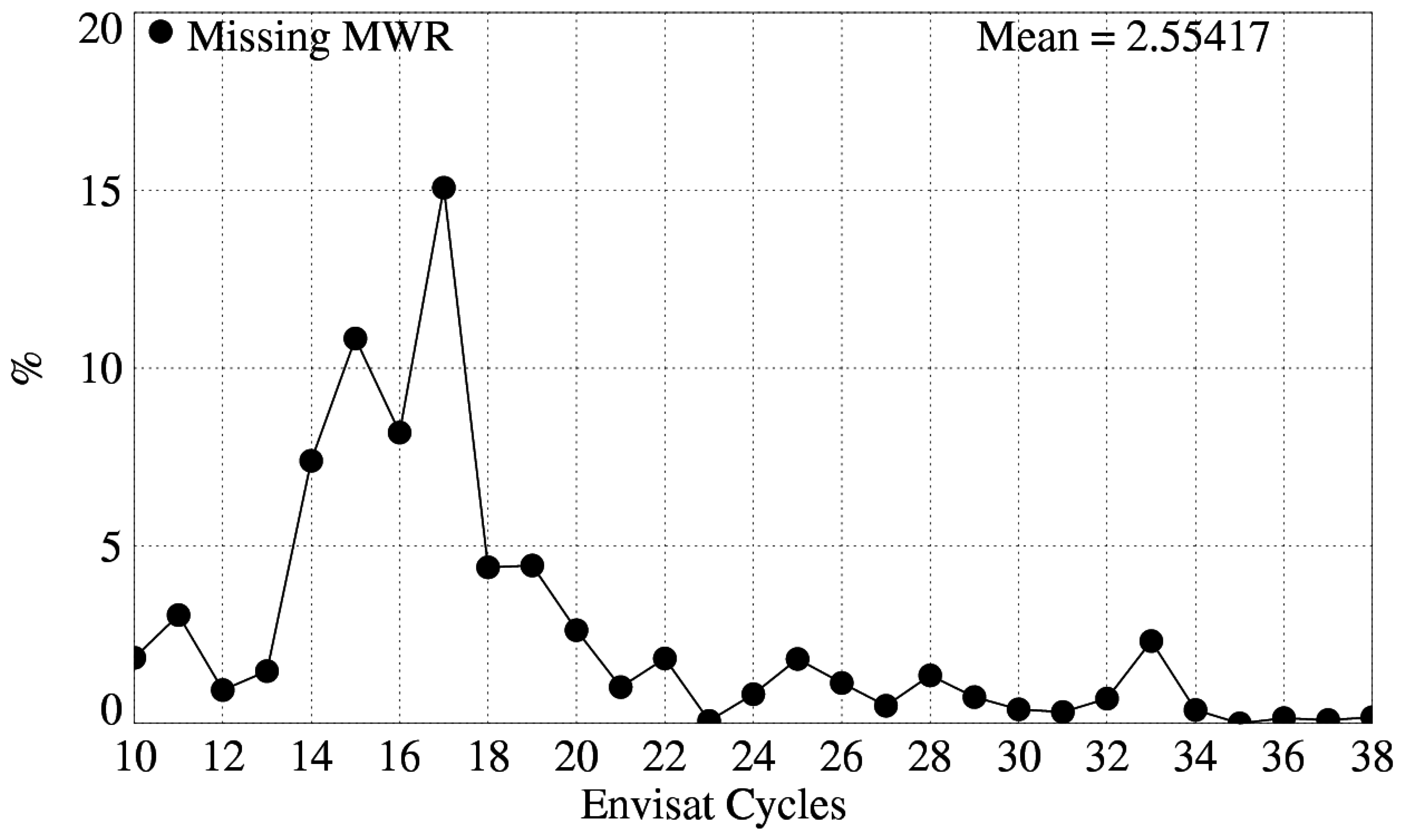
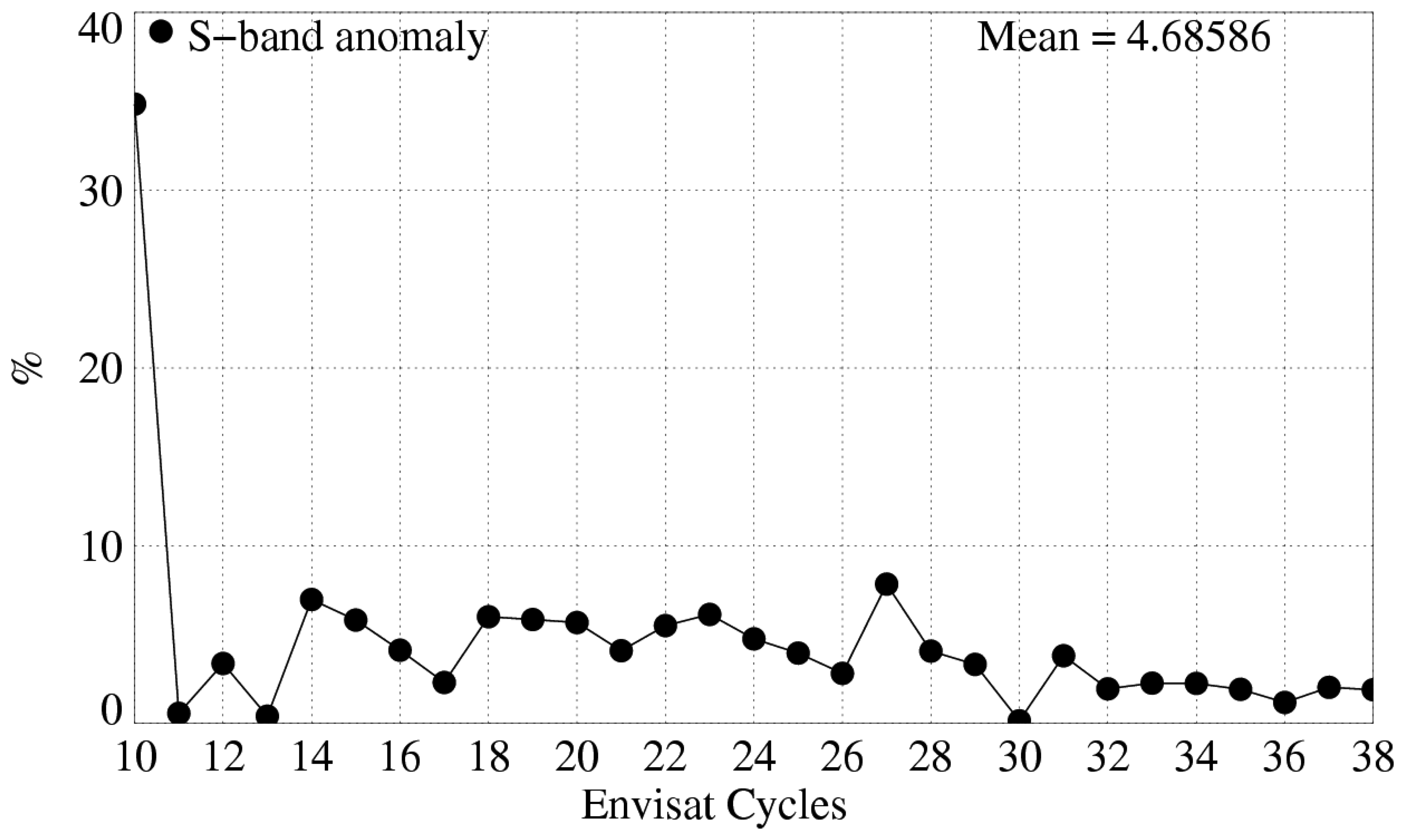
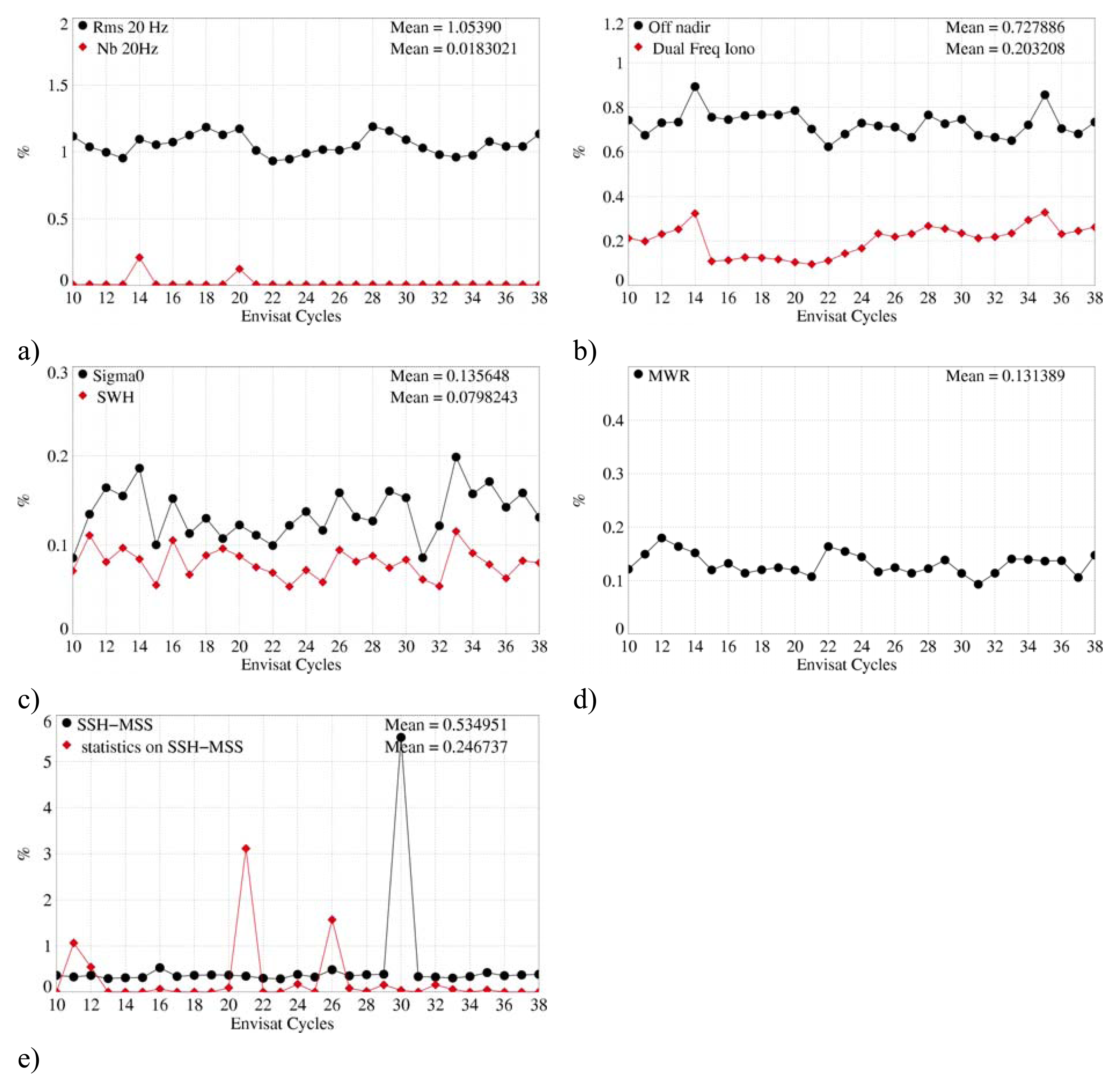
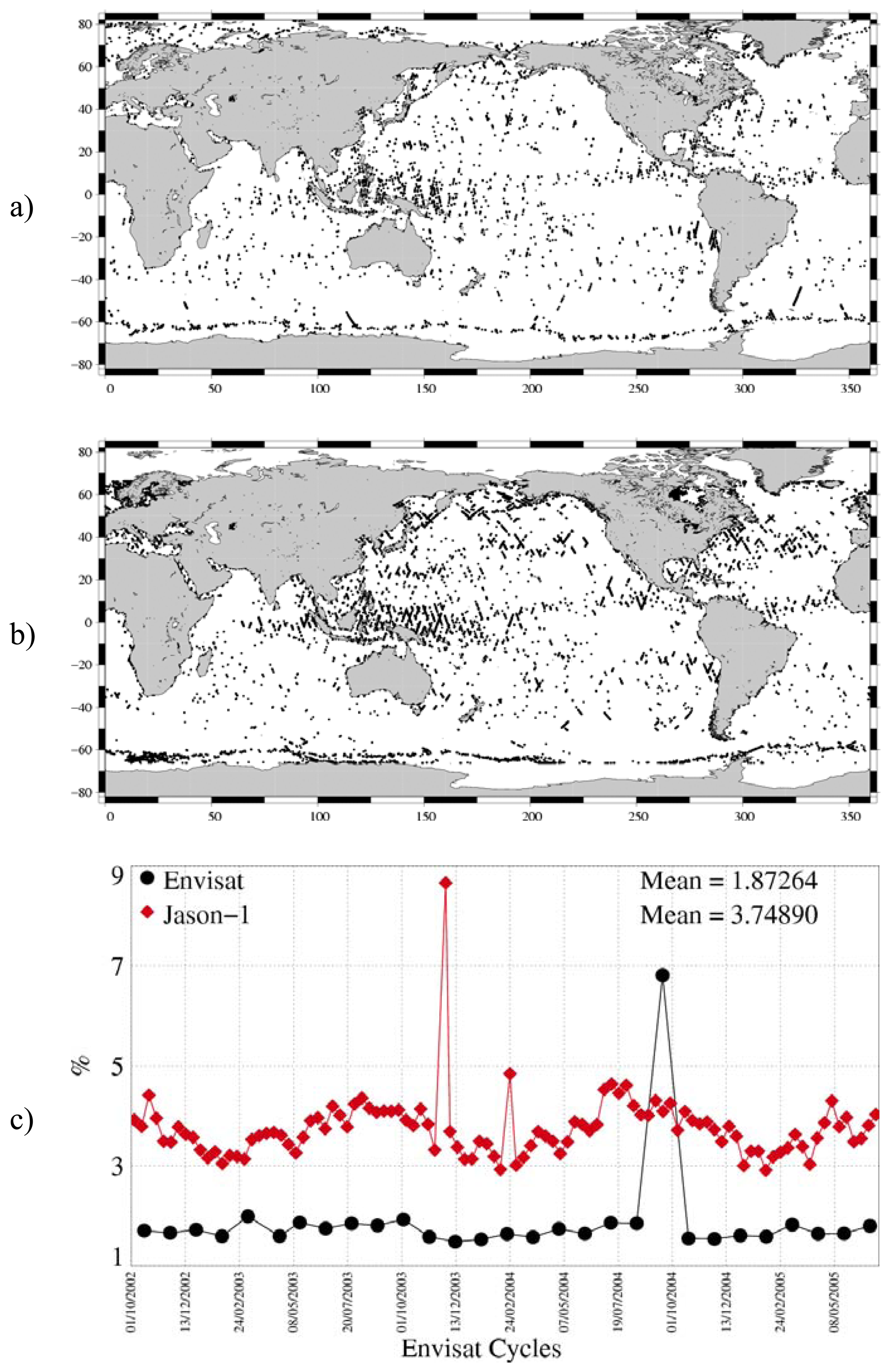
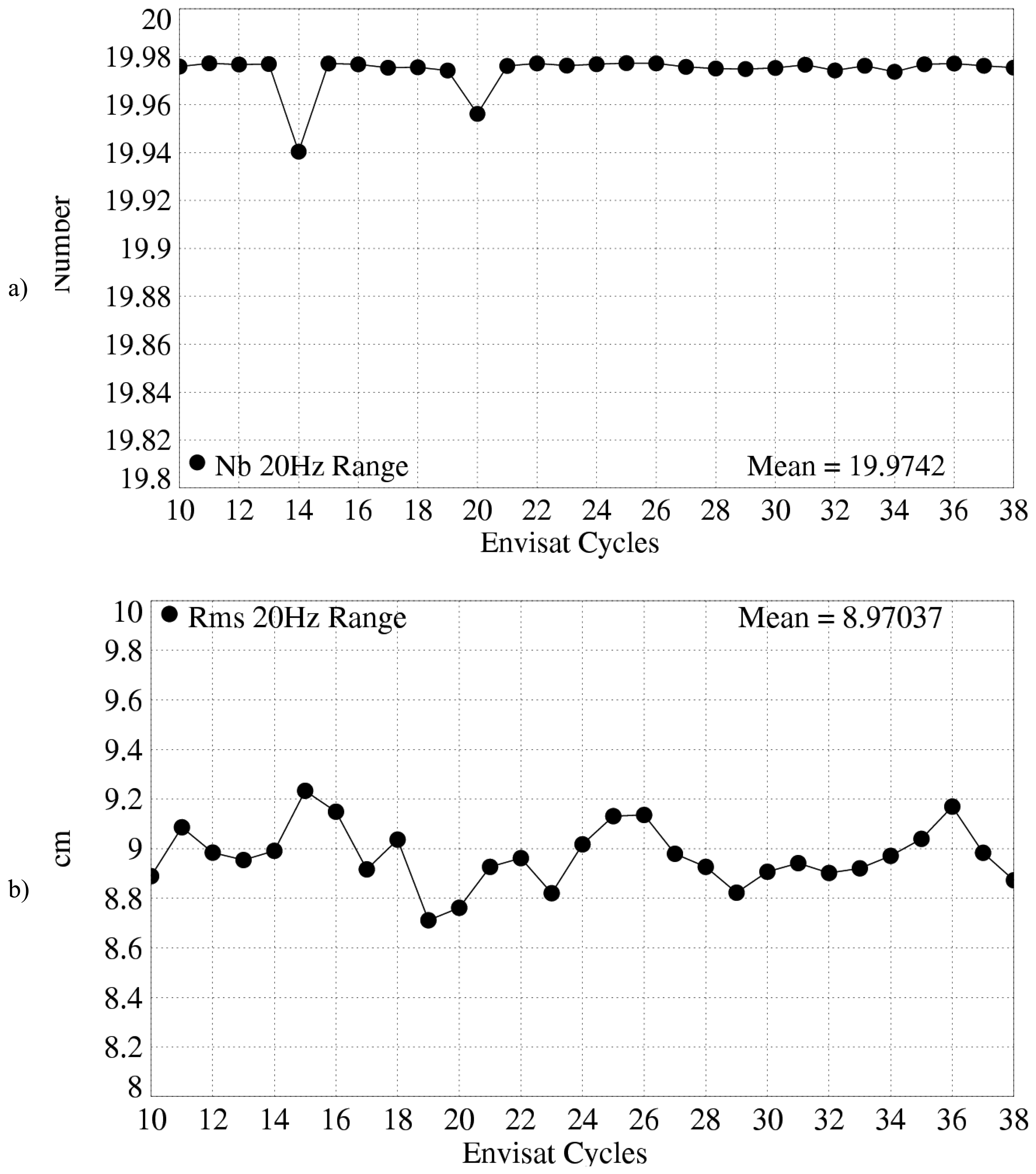
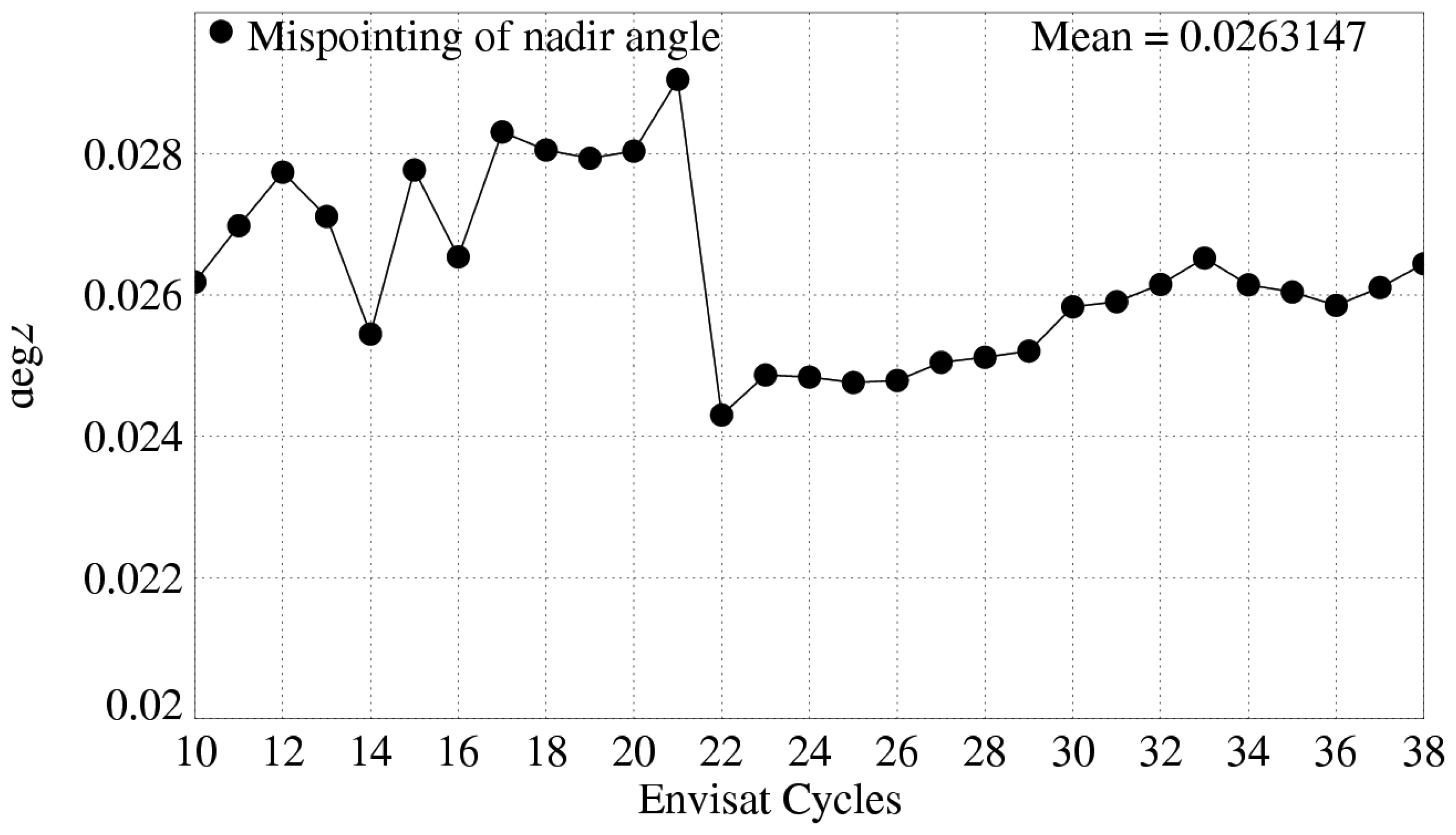
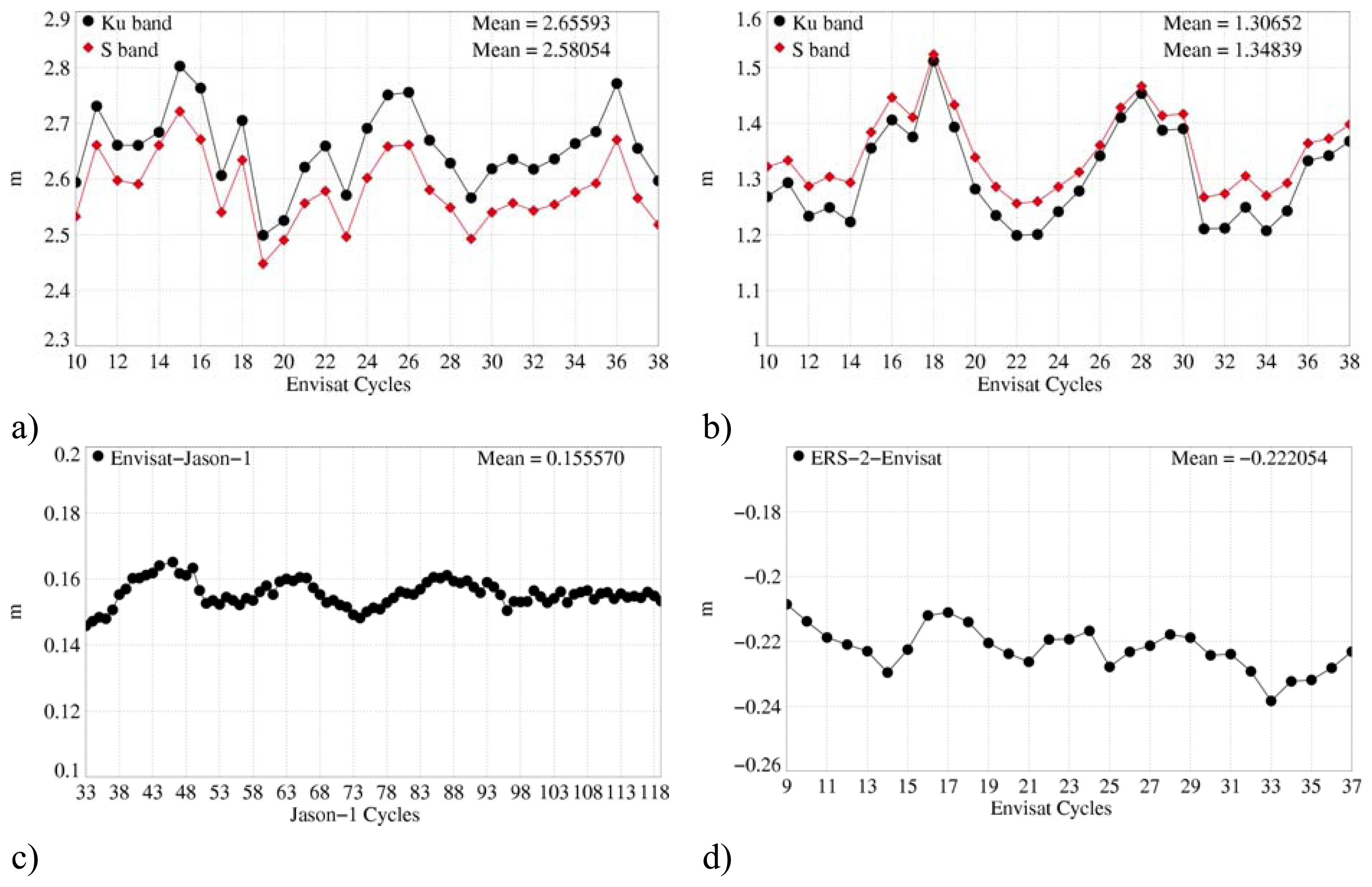

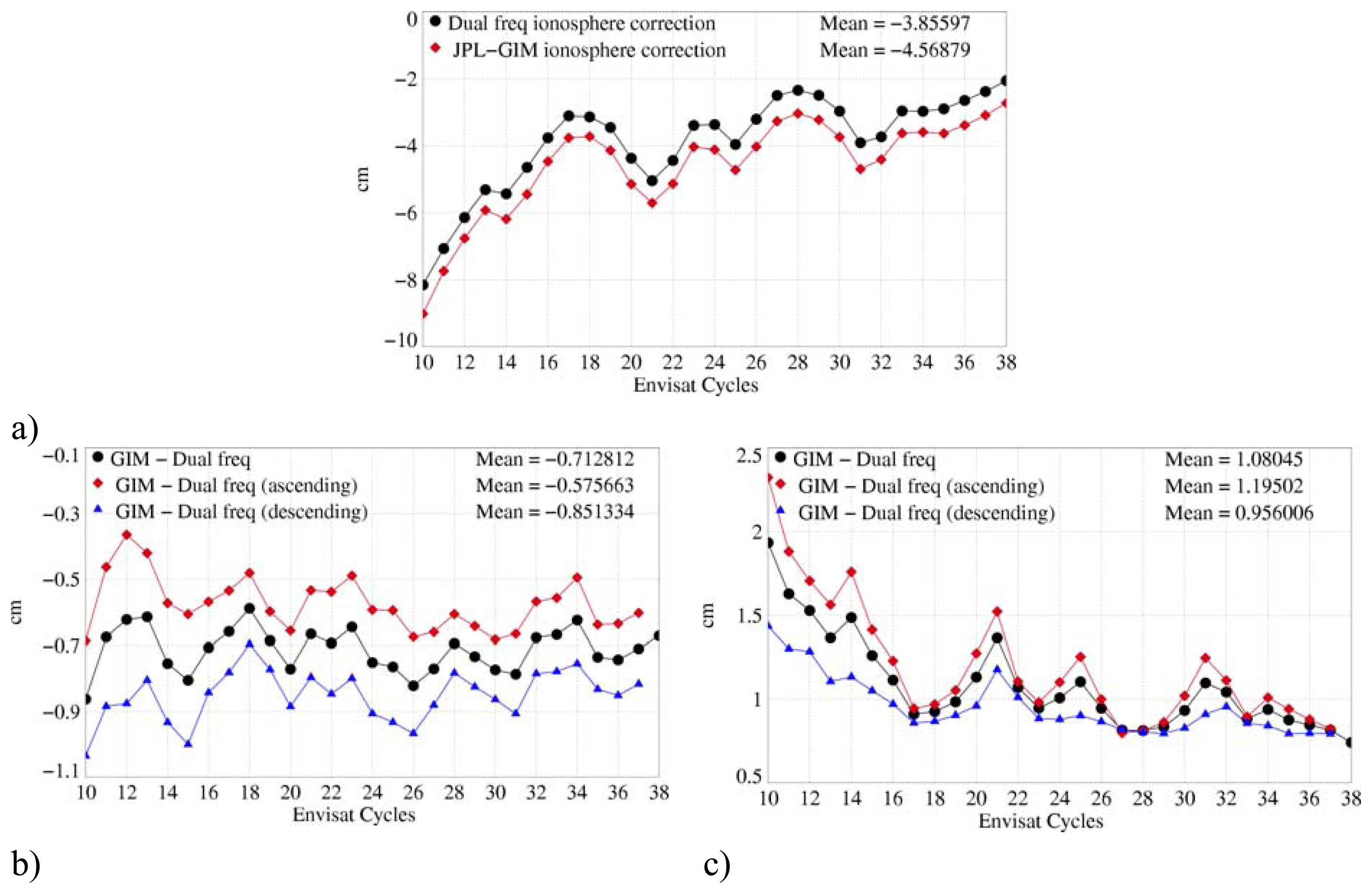
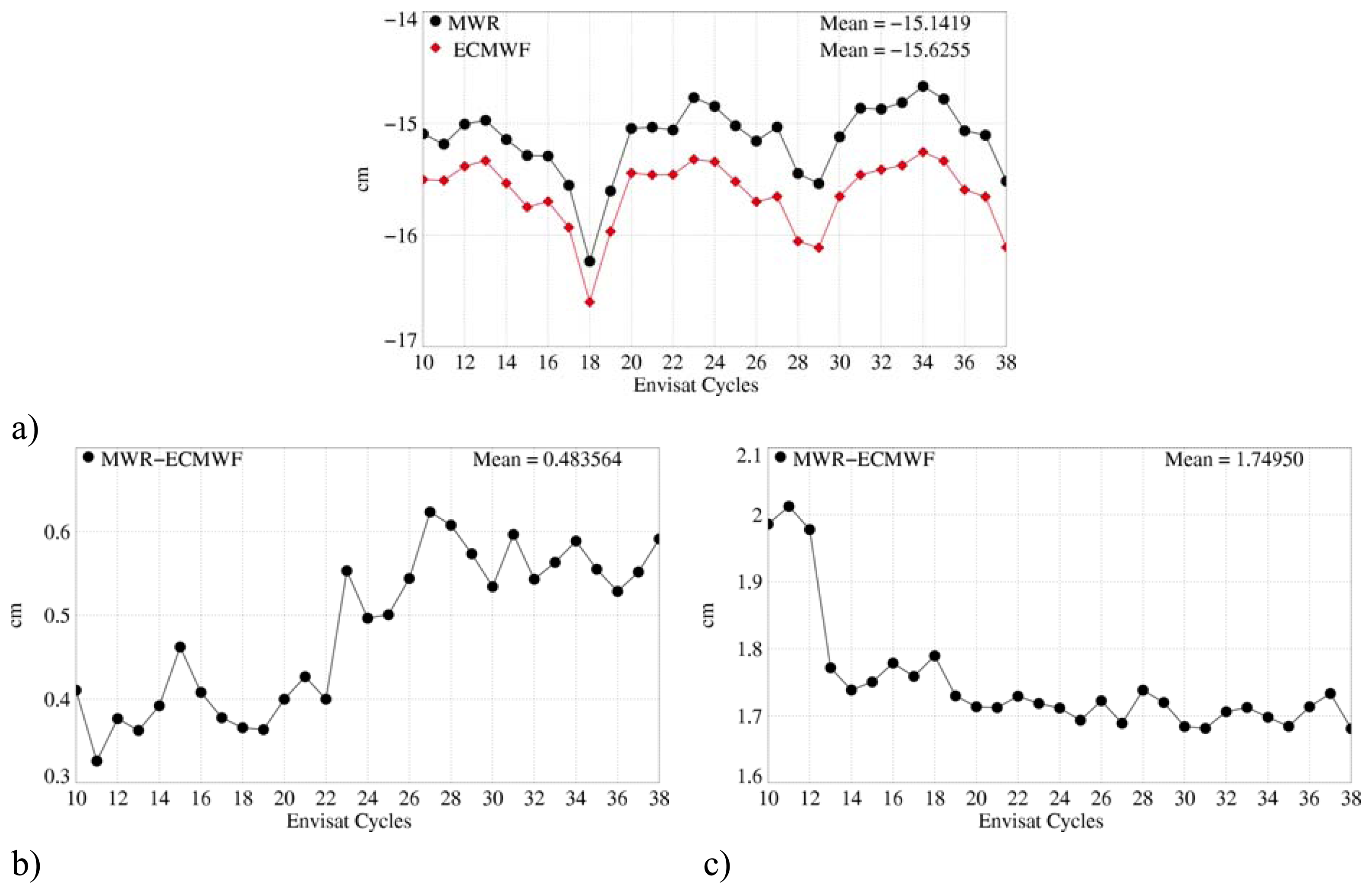
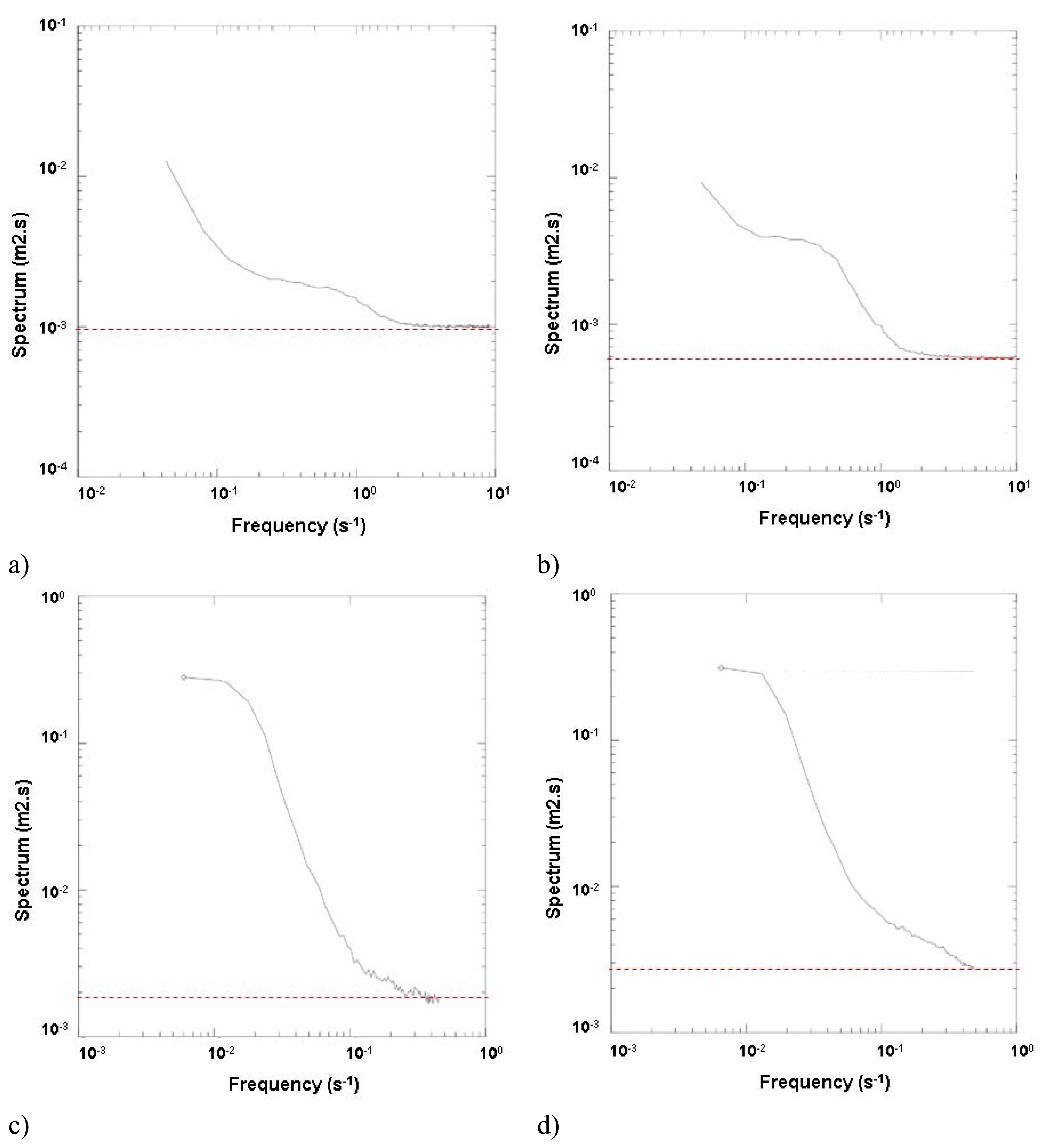
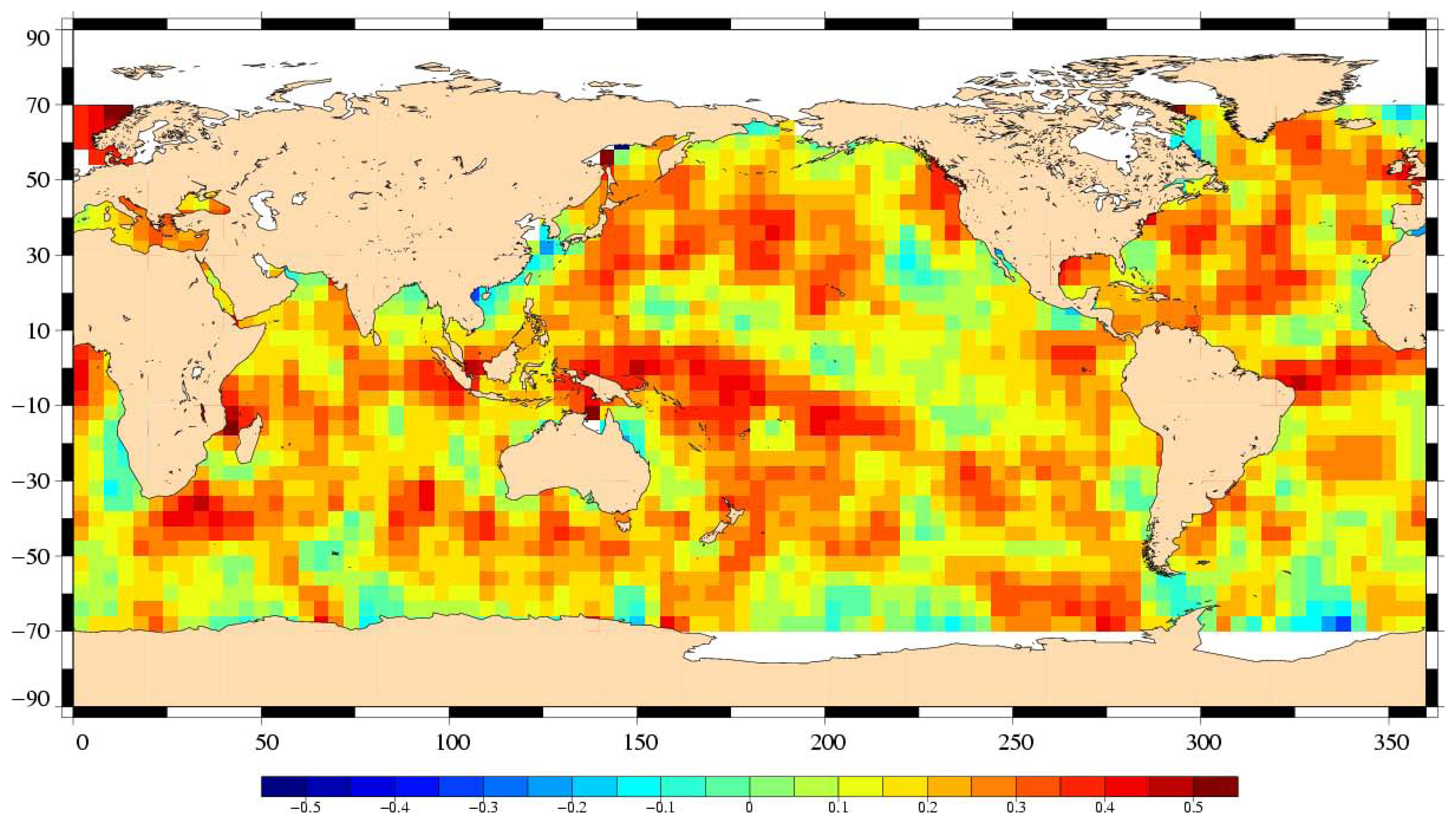
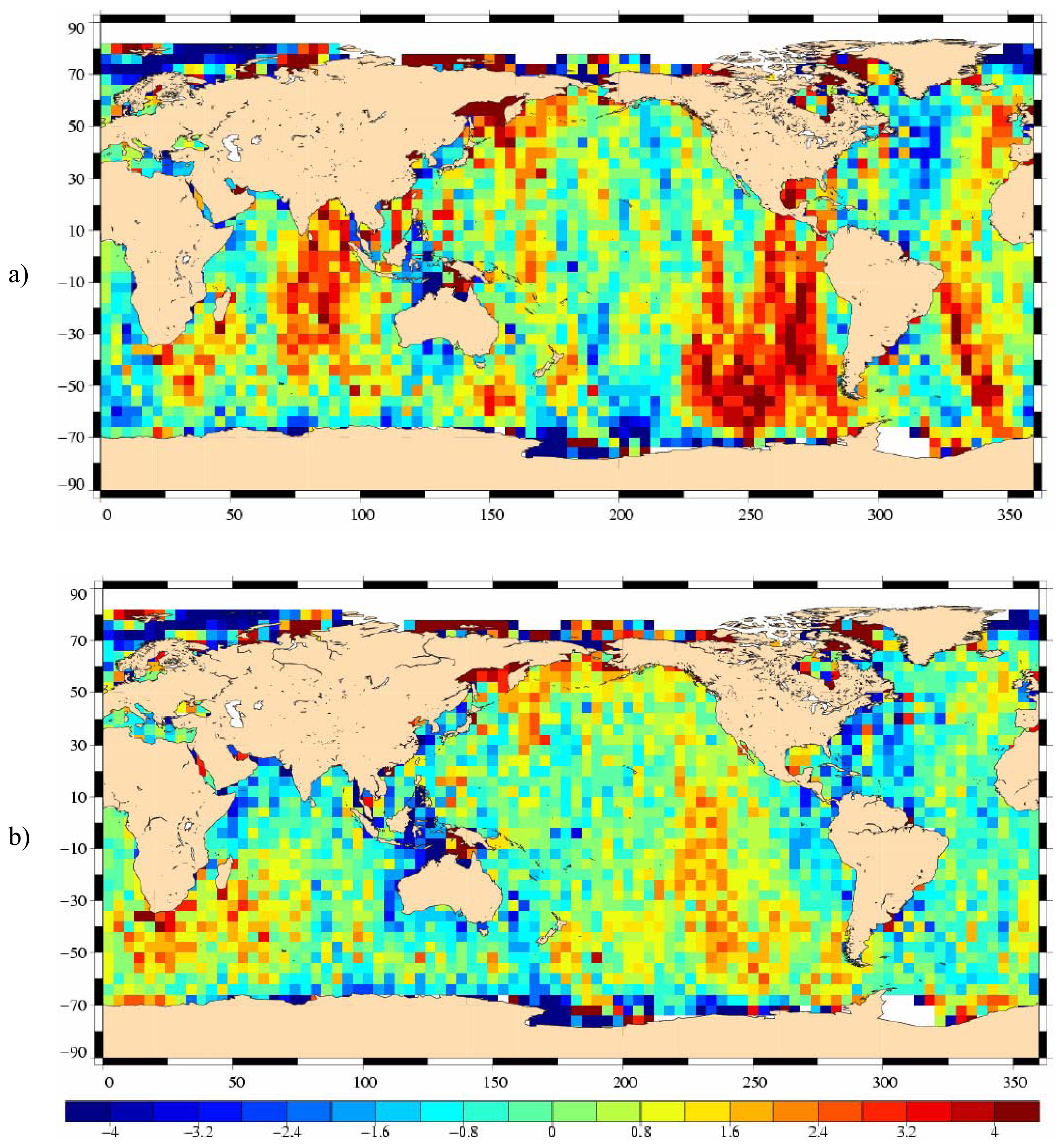
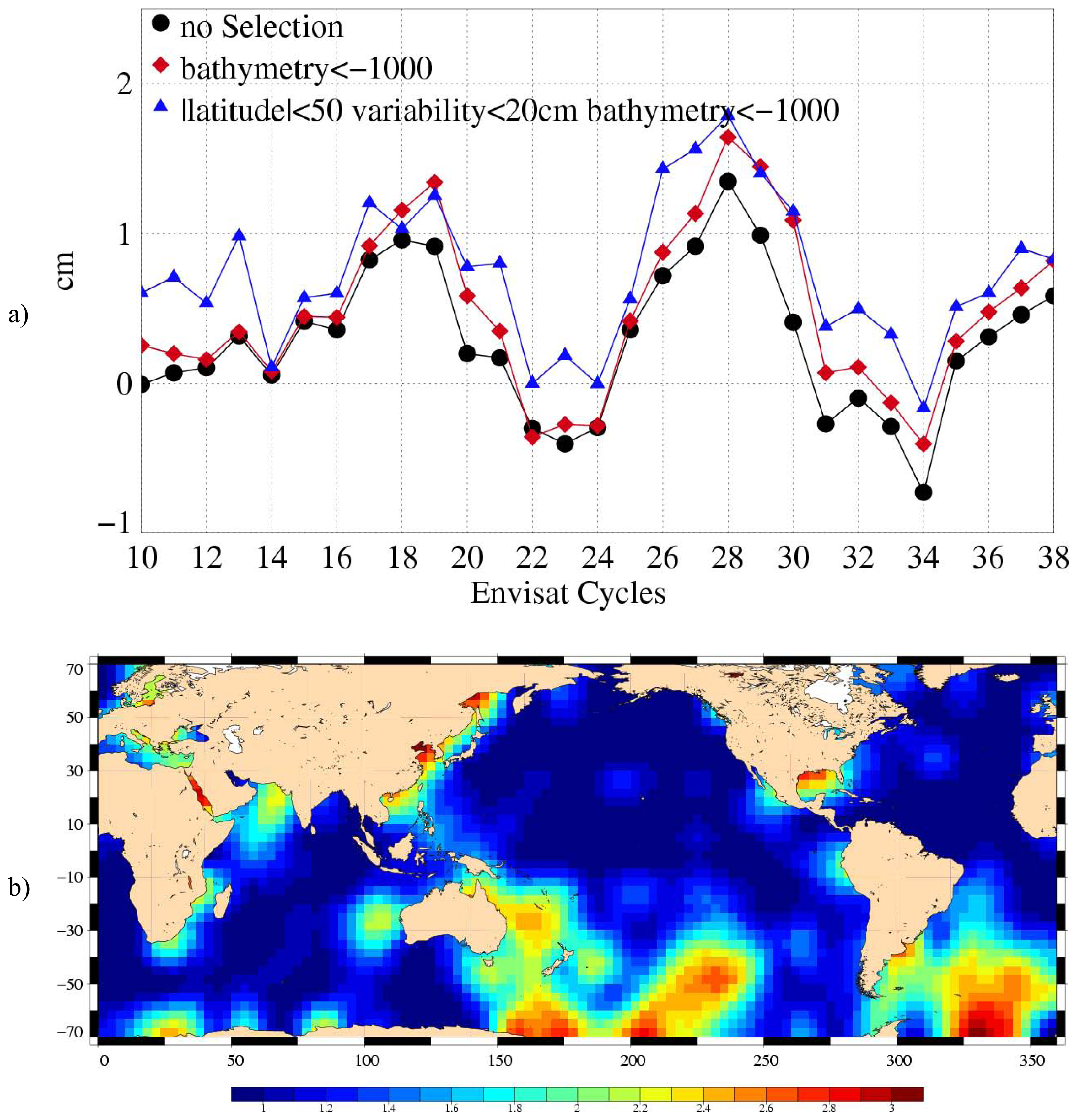
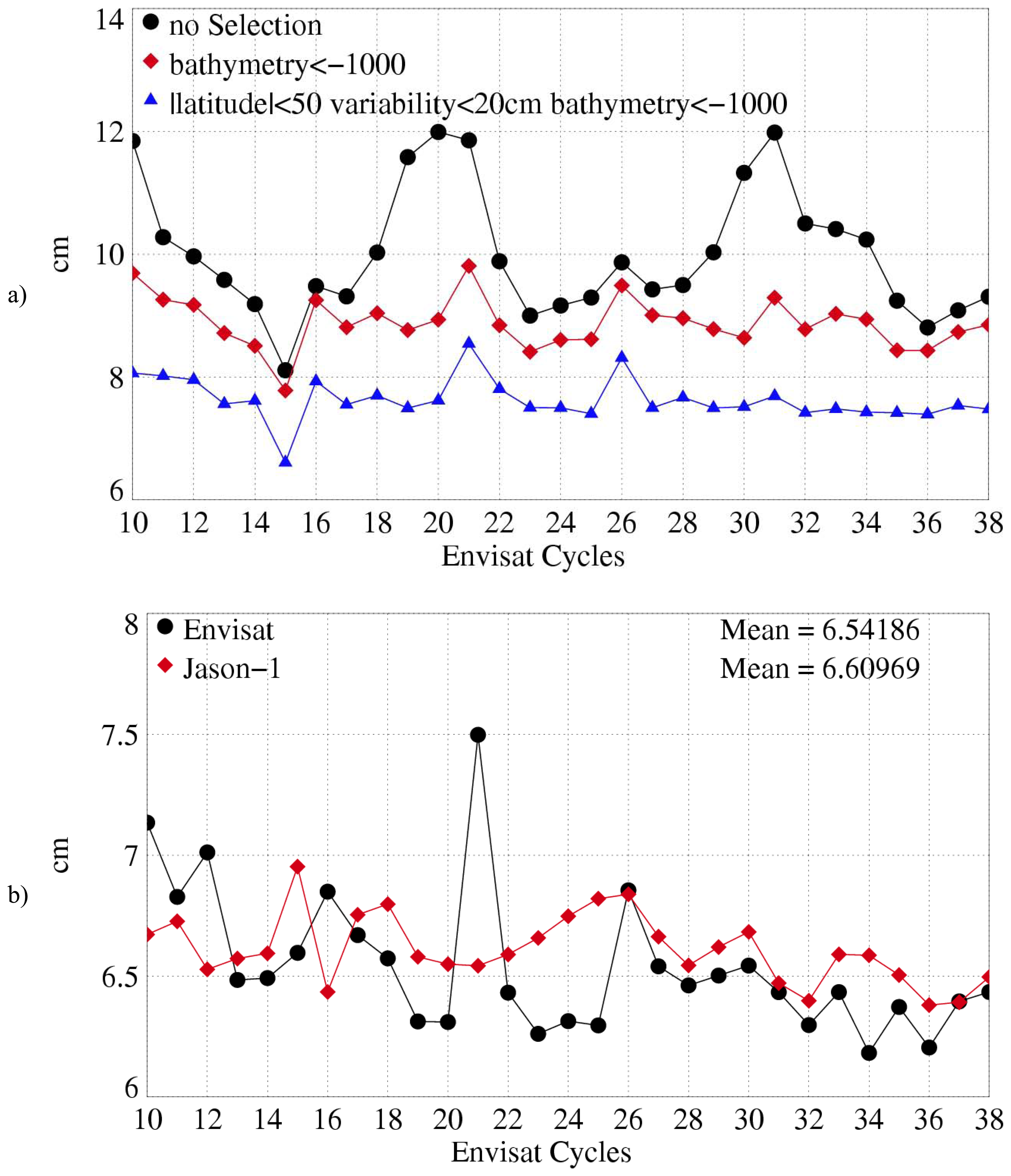

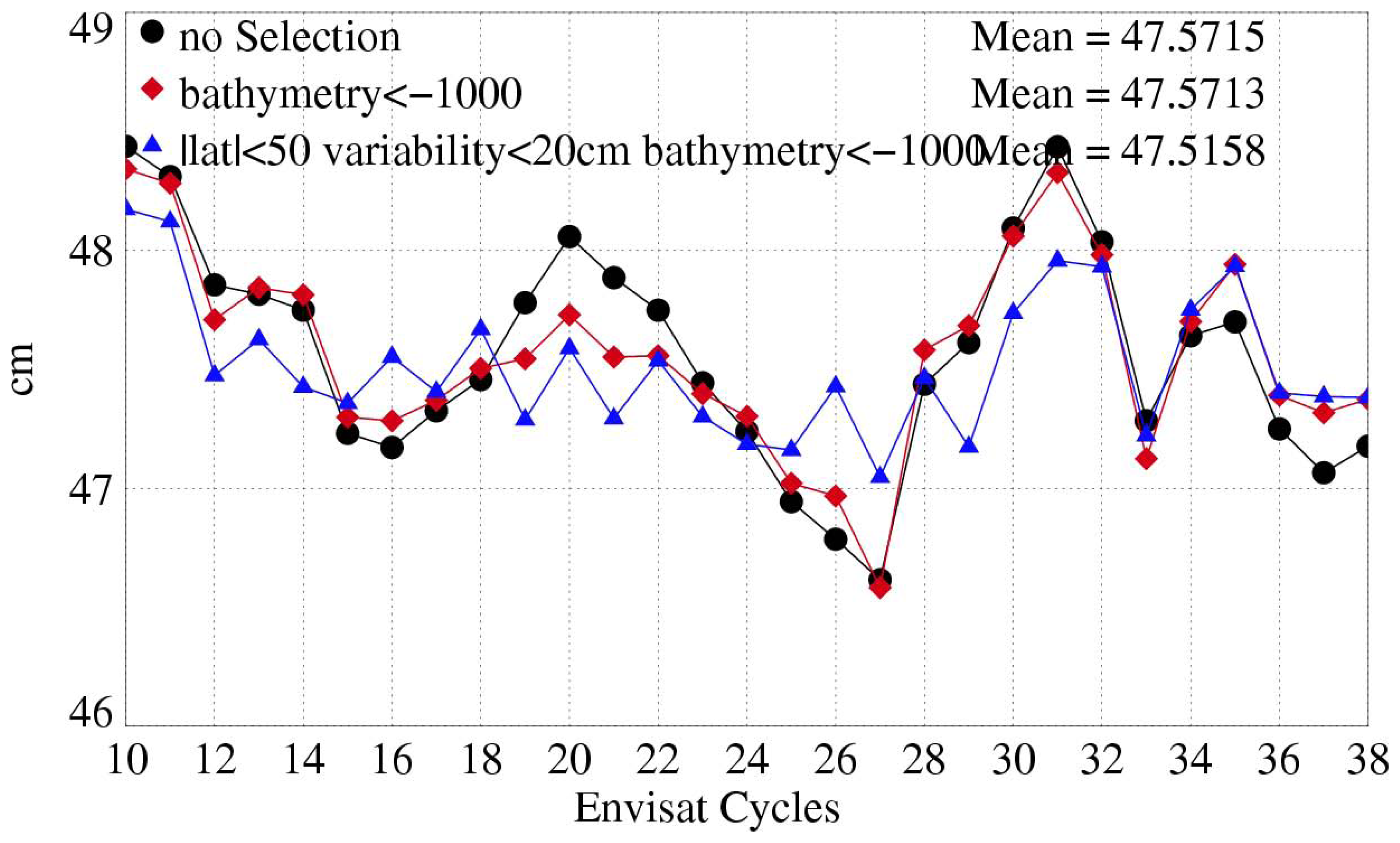
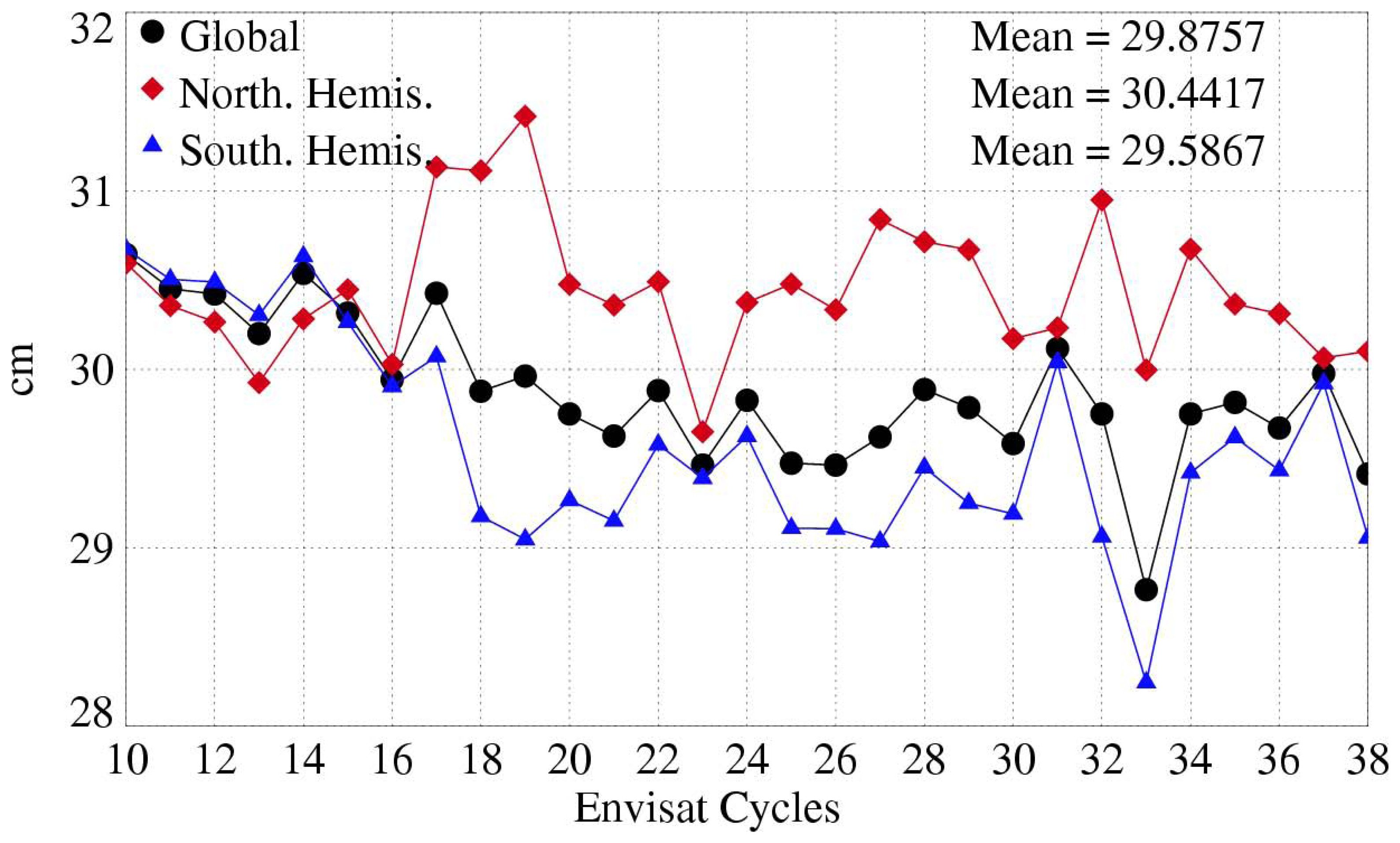
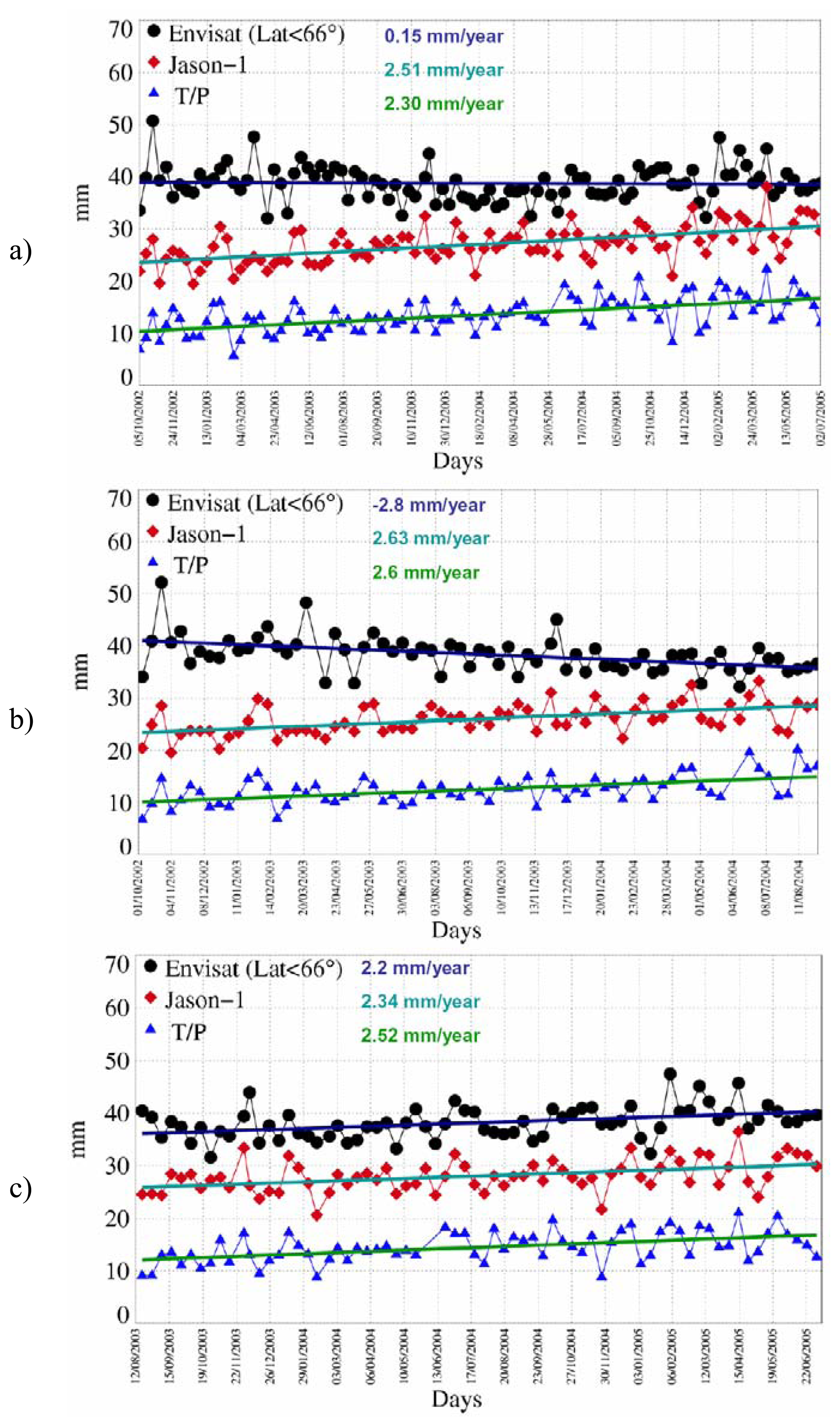

| Envisat | Jason-1 | T/P | |
|---|---|---|---|
| Orbit | CNES POE (grim5) | CNES POE (JGM3) | NASA POE (JGM3) |
| Additional Range correction | USO correction | none | none |
| SSB | Non parametric SSB (GDR) | Non parametric SSB (Labroue and Gaspar, 2002 [25]) | |
| Wet troposphere | For performance assessment: MWR For MSL estimation: ECMWF model, Gaussian grids | ||
| Dry troposphere | Based on ECMWF sea level pressure, rectangular grids | ||
| Ionosphere | Dual-frequency altimeter (filter 300km) | ||
| Inverse barometer | Based on ECMWF sea level pressure relative to global mean, rectangular grids | ||
| Tides | Pole tide, solid earth tide, GOT00.2 ocean and load tides | ||
| Mean sea surface | CLS01V1 | ||
© 2006 by MDPI ( http://www.mdpi.org). Reproduction is permitted for noncommercial purposes.
Share and Cite
Faugere, Y.; Dorandeu, J.; Lefevre, F.; Picot, N.; Femenias, P. Envisat Ocean Altimetry Performance Assessment and Cross-calibration. Sensors 2006, 6, 100-130. https://doi.org/10.3390/s6030100
Faugere Y, Dorandeu J, Lefevre F, Picot N, Femenias P. Envisat Ocean Altimetry Performance Assessment and Cross-calibration. Sensors. 2006; 6(3):100-130. https://doi.org/10.3390/s6030100
Chicago/Turabian StyleFaugere, Yannice, Joël Dorandeu, Fabien Lefevre, Nicolas Picot, and Pierre Femenias. 2006. "Envisat Ocean Altimetry Performance Assessment and Cross-calibration" Sensors 6, no. 3: 100-130. https://doi.org/10.3390/s6030100




